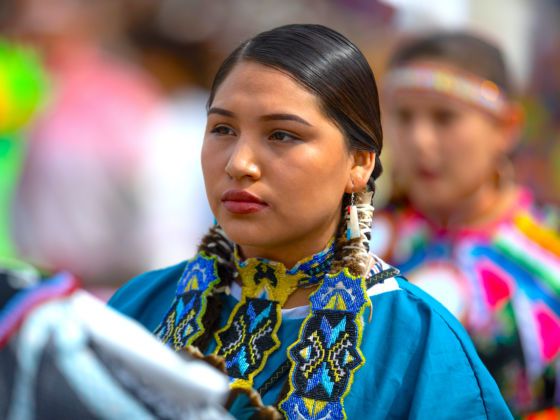Last Halloween, I was sitting on the front porch watching scrub jays dart from branch to branch. I lit candles in the pumpkins we carved and waited for the parade of kids trick-or-treating. Then came the rush of footsteps and laughter. I chatted with parents, oohed and aahed over the costumes. One kid was dressed as a purple dinosaur. Another was made to look like grapes wearing a green shirt covered with green balloons. And then there was a tiny girl with two long black braids, wearing faux-leather, dressed as Pocahontas or Sacajawea, and her dad wearing a headdress.


Why Your Native-Inspired Halloween Costume Devalues Our Indigenous Cultures
I love Halloween, but my thoughts are heavy saddlebags. It’s unintentional, of course. This father was most likely unaware that it is disrespectful to dress his daughter and himself as Native American. I could shrug it off as cultural borrowing and overlook cultural appropriation — after all, he means well. But I can’t. As Native Americans, we are a culture — not a costume. I understand that wearing a culture as a costume is not intended to hurt most of the time. However, the fact of the matter is that it does.
Native social justice activists have been speaking out against Native American-themed costumes for decades, yet companies still produce them, and stores still order and sell them. When I contacted a number of the costume supply stores in my city and state, the owners I spoke with said that their Pocahontas, Indian Brave, and Big Chief costumes are top sellers, and they would lose business if they didn’t stock and sell them. Some people wear these costumes out of naiveté and others in a blatant disregard, disrespect, and irreverence.
Our Native American regalia is a tradition for our Native people, and the wearing of it is a distinctly indigenous activity. It is imbued with spiritual meaning and an expression of culture and identity. For Native dancers, not only is the act of dancing that expression, but the wearing of dance regalia is also a visible manifestation of one’s heritage. Often the beadwork contains personal motifs that reflect the dancer’s tribe, and beadwork is frequently created by a family member and given as a gift to the dancer.
Feathers receive utmost respect. Regalia is one of the most powerful symbols of Native identity and is considered sacred. This is one reason why it is inappropriate to refer to regalia as a “costume.”
However, we (by “we” I mean American society) are stuck in a mode where too many people tolerate imitating American Indian people. These activities are indicative of an ignorant society that refuses to see American Indian people as people.
Most damaging are the Halloween “Pocahottie” and “Sexy Indian Girl” costumes which have gained popularity. I can begin by referencing statistics about how many Native women are sexually assaulted (one in three). The rate of sexual assault is more than twice the national average, stressing the point that dressing up and playing Indian is not a harmless activity.
When a costume or sexiness is based on race, ethnicity, or culture, humans are being extracted for the sake of making the wearer of the costume feel powerful or exotic. There is also cultural appropriation. It involves members of a dominant group exploiting the culture of a less privileged group and equals belittling the lived experience and ethnicity of those who have birthright.
Native American people are among the most underrepresented and misunderstood minorities in all of North America. Too often the First Americans are depicted as existing during colonization and western expansion as if belonging only in the past, but not as people in today’s world. No myth about Native people is as prevalent, or self-serving, as the myth of the vanishing Native, also known as “the vanishing Indian” or “the vanishing race.”
It’s no surprise that so many feel that wearing Native American-like regalia as a costume isn’t offensive — because in their mind Indians no longer exist.
A version of this article was previously published on October 24, 2016, and was updated by the author on August 17, 2020.